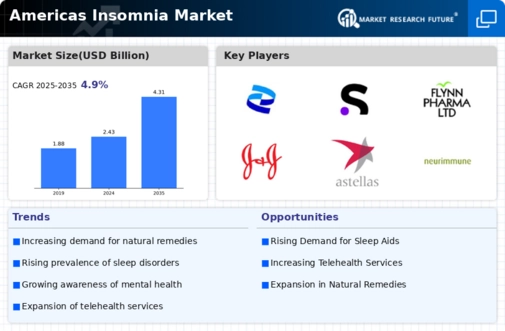Market Trends
Key Emerging Trends in the Americas Insomnia Market
The Americas Insomnia market is witnessing significant growth due to the rising prevalence of insomnia across North and South America. Lifestyle changes, high-stress levels, and the impact of modern technologies are contributing factors to the increased incidence of sleep disorders. As awareness of the importance of sleep health grows, more individuals are seeking solutions for insomnia, driving market expansion. In the Americas, the pharmaceutical strides as insomnia treatment are still the predominant market players. Benzodiazepines like the sleep drugs as well as the non-benzodiazepine-receptor agonists and melatonin agonists still stand out as the prime approaches in the context of relieving cardinal insomnia symptoms. A kind of medication-oriented medical market has arisen, giving patients the choice between prescription and over-the-counter medications, both with the goal of treating insomnia. One of the most distinguishable tendencies in the Americas’ insomnia market is a growing attention to non-pharmacological approaches for the treatment of insomnia. Cognitive Behavioral Therapy for Insomnia (CBT-I) as well as sleep hygiene education and relaxation techniques are gaining popularity among physicians and psychologists as efficacious methods which work either help or in conjunction with medications. Such as this development will define the increasing attention on the whole treatment that is connected with lifestyles of people for the disorders of insomnia. The shape of the modern market is changing with regard to the adoption of digital healthcare for the sleep tracking and management. Wearable devices, mobile apps, and home automation system are what is being utilized to monitor sleep patterns, offer actionable insights, and prompt feedback. This digital tendency is the indication of the expansion of self-tracking and an eagerness for individuals to take the preemptive measures to improve sleep health. Taking the lead in adopting telemedicine in the Americas market of the insomnia industry. The technology of telemedicine makes it possible to transmit information through various channels, including remote consultations with sleep specialists which is a crucial step in the diagnosis and treatment plans. This movement expands the access into sleep medicine and even facilitates individuals in the hidden zones and underserved areas of the world. The research highlights that there is the increasing attention towards children insomnia problem within the country. This interest for sleep is more being stoked in children and teens with an increasing number of customized solutions becoming popular. Healthcare providers, who are already addressing the peculiarities of pediatric insomnia, are now drafting their own treatment options, directed especially for this age group. The last couple of years have seen consumer preference for herbal and natural treatments to manage sleeping problems markedly increase. Natural medicinal plants, herbal teas and results-based products containing the like of valerian root, chamomile and lavender are getting popular. This is seen as a shift among consumers from rather chemical or pharmacological sleep remedies to more natural and holistic methods of treatment of sleep complaints.
Ongoing research in the Americas is exploring the complex relationship between insomnia and comorbidities such as anxiety, depression, and chronic health conditions. The market is responding with targeted interventions that consider the interconnected nature of sleep disorders and associated health issues. This research-driven trend is influencing the development of more tailored and effective treatments. Stringent regulatory compliance requirements for insomnia treatments, including medications and digital health solutions, are shaping market dynamics. Manufacturers and service providers are focusing on adherence to safety standards and regulatory guidelines to ensure the reliability and safety of their products. This commitment to compliance enhances the market's credibility and fosters trust among healthcare professionals and patients.










Leave a Comment